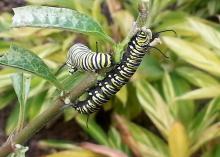Information Possibly Outdated
The information presented on this page was originally released on April 1, 2019. It may not be outdated, but please search our site for more current information. If you plan to quote or reference this information in a publication, please check with the Extension specialist or author before proceeding.
Interest in home butterfly gardens is increasing
There's still plenty of time to plant some butterfly weed in your home garden and enjoy colorful Monarch butterflies as they visit this summer.
The momentum of creating home butterfly gardens is increasing. The interesting thing about these gardens is the fact home gardeners are wanting to grow plants to be eaten by caterpillars.
Wow, what a change. I usually get questions about how to get rid of caterpillars eating the garden plants. But to get the beautiful butterflies, the caterpillars need something to forage on.
Planting a butterfly garden involves knowing what kind of caterpillar/butterfly you’re trying to attract. Most of them have a preferred food source. For example, Giant Swallowtails prefer citrus, and I love watching the dance these butterflies perform while laying eggs. Their caterpillars are the ugly Orange Dog, or more colorfully named “bird crap” caterpillars.
But, for this column, I want to concentrate on what could be called America’s butterfly: the Monarch. Their caterpillars exclusively eat the foliage from Asclepias species, which we call butterfly weed. It’s a unique arrangement, as toxins produced by these plants are safe for the caterpillars, but poisonous for their predators.
Butterfly weed is low maintenance, attracts lots of Monarchs and other butterflies, and is deer resistant. They are great choices for home landscapes.
These plants are also called milkweed for their milky-white latex sap. There are several species native to Mississippi, but perhaps the most well-known species is Asclepias tuberosa. This native perennial plant, chosen as a Mississippi Medallion winner in 2012, grows well across the state.
Clusters of tubular flowers, which become prominent in late summer and early fall, are various shades of orange, but some will have flowers shaded towards yellow or red. They’re easy to grow from seed in a container and can be transplanted when large enough.
Asclepias currassavica is a nonnative tropical milkweed that blooms from spring through the fall. Many garden centers carry this plant, which will provide early-season forage for caterpillars.
The problem I’ve observed with tropical milkweed is it is also a magnet for aphids. While they are unsightly, aphids don’t seem to impact growth and flowering. I don’t want to use pesticides to remedy the problem, but blasting the plant every couple of days with the garden hose does knock off many of the pests.
Don’t rely entirely on this species. There is concern about overwintering tropical milkweed being a host to protozoan parasites that can harm butterflies. A couple of these fast-growing plants would be a good source of forage until our native species start producing more foliage.
A fun forage plant that the Monarch caterpillars love is Gomphocarpus physocarpus, commonly called balloon plant or hairy balls. This plant produces 2- to 3-inch, lime-green seed pods.
If you’re interested in starting your own butterfly garden, watch the Southern Gardening TV segment, Butterfly Gardening from Scratch (http://extension.msstate.edu/southern-gardening/video/2019/butterfly-gardening-scratch).
If you have a butterfly garden, you can join a unique project. The Rosalyn Carter Butterfly Trail starts in Plains, Georgia, and there are registered butterfly gardens across the United States. In fact, my home garden is a registered stop on the trail. For more information, visit http://www.rosalynncarterbutterflytrail.org/home.


